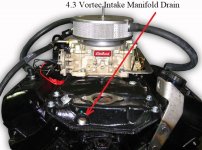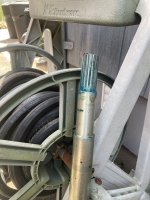Yes you need to drain out the water first. Or else the stat won’t open & all the AF will go out the exhaust manifolds.this will fill the manifolds but leave the block full of raw water and it will crack when the temp
drops. Plus running in the AF uses more AF than manually filling and also an engine with an engine mounted impeller like the Volvo may not be able to pull in the AF with just a gravity feed. This may burn up the impeller & overheat the engine! So I don’t advise doing it that way.
Start with changing the motor oil & filter & the gear oil in the outdrive. Then run the engine again check for leaks & fog it thru the carb.
The way I’m describing below involves manual draining and manually adding -100 Marine AF, IMHO it’s the safest best way. Adding the AF is optional that’s up to the owner. The basic principle is you must get ALL the raw water out of the engine, manifolds, impeller housing and hoses/coolers.
First lower the outdrive that helps it drain There are drains on each exhaust manifold (aft end or bottom ) and on both sides of the engine block; one is in front of the starter & the other is in front of the oil filter mount. Poke the holes with a pick or similar to make sure they drain.
Next you must disconnect the bottom end of the big hose up front that connects the front circulation pump & the thermostat housing. Next you disconnect the raw water intake hose that comes from the transom and goes to the impeller housing. Hold this down to drain it; I’d also then hold it up and fill it with -100 marine AF till it runs out the water intakes. This pushes any raw water out of that hose & the P/S cooler on the back of the engine.
Next you put the drain plugs back in. Reconnect the raw water intake hose. Reconnect the bottom end of the big hose & disconnect the top end at the stat housing. Now fill that hose with -100 marine AF till is spurts out of the neck of the thermostat housing. Re connect that hose. Next disconnect the feed hoses for the exhaust manifolds at the stat housing. Now fill each manifold with the same AF till it runs out the exhaust housing under the transom mount, then you’re done.. This is the safest way to use AF.
You drain to prevent freeze damage and add AF (optional) to reduce corrosion. After doing this I spray the engine with corrosion X in particular the oil pan, these can rust if it’s a steel pan like you will find on the older 4.3s same with the timing chain cover. Newer 4.3s use an aluminum pan and plastic or alu timing chain cover. If yours is a 99 or a 2000 it’s the newer style, my old 1988 had the steel covers so I spray them with corrosion X. It does work to reduce corrosion.
About antifreeze realize that you want to use marine AF with corrosion inhibitors and that if it gets below about 15-10*F the -50 & -60 will get hard, I would use -100,it’s good to way below zero.I tested -50 & -60 in my freezer at zero and both got hard and IMHO they don’t belong in a cast iron engine if your temps get below 15-10*F.





















